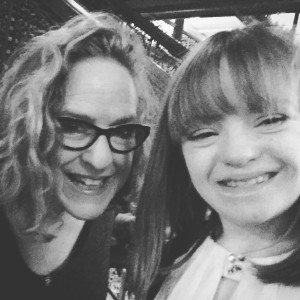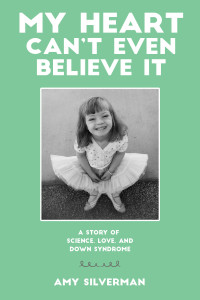Last summer I had the privilege of reading an early draft of Amy Silverman’s new book, which launches May 1 at Changing Hands Bookstore in Tempe. My Heart Can’t Even Believe It is a strikingly honest memoir that blends investigative journalism and personal narrative to explore what it means to raise a child with special needs—Amy’s 12-year-old daughter, Sophie, has Down syndrome.
With a journalist’s heart (she is managing editor of Phoenix New Times and has twice been named journalist of the year by the Arizona Press Club), Amy asks hard questions about biology, about history, about motherhood, about discrimination, about the future, about Sophie, and about herself. Most of the time she finds the answers, but her daughter—who is a remarkable and charming girl—continuously surprises her mother by defying all expectations and refusing to be solved.
Like Sophie, My Heart Can’t Even Believe It is fearless, honest, and beautiful.
Click here to pre-order the book through Changing Hands Bookstore, which comes with two tickets to the launch party!
My Heart Can’t Even Believe It is also available for pre-order from Amazon and Barnes & Noble.
About the Book:
In MY HEART CAN’T EVEN BELIEVE IT, journalist, blogger, and NPR contributor Amy Silverman tells the story of the birth and growth of her daughter, Sophie, and the Down syndrome diagnosis that changed everything. Amy wrote the book she desperately wanted to read but couldn’t find, meant not just for parents of kids with Down syndrome, but rather a story for anyone touched by disability, a story about science, and a story about being different: something that all of us can certainly identify with. It’s part memoir, part investigative reporting, part parenting manual — a crash course in genetics, history, politics, pop culture, education, medicine, health care policy, marriage, motherhood and family.
About the Author:
Amy Silverman is managing editor at Phoenix New Times and a commentator for KJZZ, the National Public Radio affiliate in Phoenix. Her work also has appeared on NPR’s This American Life and in The New York Times. Amy holds a master’s degree in journalism from Columbia University. She lives in Arizona with her husband Ray and daughters Annabelle and Sophie.
Find Amy online at her website, myheartcantevenbelieveit.com.
Elizabeth: You’ve been blogging about your daughter Sophie for nearly eight years. What inspired you to begin sharing your stories, and when did you decide to turn those stories into a book?
Amy: I actually shared my stories about Sophie long before the blog came along. Around the time my first daughter, Annabelle, was born, I began to write memoir – inspired mainly by the now-defunct section on salon.com called “Mothers Who Think” as well as Anne Lamott’s work and what I was hearing on “This American Life,” the public radio show.
I did a few stories for the local NPR affiliate here in Phoenix and managed to get a couple published on Salon. Around that time I also began to teach Mothers Who Write, a local writing workshop I co-teach with Deborah Sussman (and where I met you – yay!). All the memoir stuff started to fall together; I was hooked.
Deciding to start a blog was not easy – I’m old and was not an early adapter of the Internet and all it has to offer. (To say the least.) A co-worker at New Times convinced me to start a blog with the goal of getting me to understand what the company was trying to do online. As a journalist I’d been taught to never give my work away, but I was intrigued by the idea of telling the story of Sophie’s kindergarten year. I started and haven’t stopped, although I’ve slowed down.
And as for the book, to my dismay Sophie did not come with an instruction manual. Not one I was prepared to read. Everything was either too sciency or too touchy-feely – not real. Not my reality, anyway. (Which is not to say that there aren’t great books out there about DS – there are.) As Sophie grew, and as my shock (and awe but mostly shock, I have to admit) wore off, I began to explore what it meant to have a kid with Down syndrome in the 21st century. It felt like a book. So I pursued that.
My Heart Can’t Even Believe It combines personal narrative with investigative journalism. Can you describe your writing process? How did you approach blending these two different writing styles?
First, I had some amazing role models. If you are at all interested in the genre, I recommend The Spirit Catches You and You Fall Down by Anne Fadiman and Crazy by Pete Earley.
Fadiman’s book goes back and forth between a very specific narrative and some wonderfully vast political and historical perspective about the Mong people. Earley, a longtime newspaper reporter, writes about his son, who is seriously mentally ill, and then reports on what it’s like to be SMI in the Miami jail system. Different approaches, both super powerful, both moving from a specific storyline to a broader one.
I read Fadiman’s book when Sophie was in the hospital for open-heart surgery and the book really opened my (sleep-deprived) eyes to the possibility of a different kind of story telling. I’d been trained to never, ever use “I” in my writing as a journalist. Totally forbidden. On the flip side, in my other life as a memoir writer and teacher, there was no reporting.
I began to wonder what would happen if I mixed the two – and then I did, in a story for New Times when Sophie was very young. It worked for me. I was hooked, and began looking for different ways to do it more.
Along with raising two daughters, you are managing editor of Phoenix New Times, run several writing workshops a year, and blog regularly at girlinapartyhat.com. How do you balance work, family, and creative writing time?
It’s not pretty. My husband would tell you I am not very good at it. I am lucky to have a day job that has turned into a 24/7 job as journalism has changed and while that sounds like a negative, it’s been my saving grace because it means that I can slip away during the day for a kid’s school event and make the time up super early the next morning before my family wakes up.
I don’t sleep as much as I should and my closet’s a wreck but if I don’t get that creative time I’m just a miserable person to be around. And family time is not negotiable. I’m not sure that answers the question. There’s an element of smoke and mirrors as well. A lot of time in the car and on the iPhone.
When did you tell Sophie you’d written a book about her and what was her reaction?
People think this is weird and I have to agree, but I didn’t really tell ANYONE about the book until I actually signed a deal with a publisher. I am terribly superstitious (and maybe a little insecure) and at so many points I was unsure it would ever happen. So a few of my writer friends knew and that was it. I told Sophie a few months ago. She was (and continues to be) thrilled. I should hire her to be my publicist.
The first complete draft was due to my editor last fall and on the day it was due Sophie shook me awake, saying, “Your book is due today! Your book is due today!” When I dropped her off that day she instructed me to go print out a copy and leave it at the school office so she could read it. And she was disappointed when it was not available for her winter non-fiction book report project. She is very excited.
Writing memoir means asking hard questions about ourselves and answering those questions with unflinching honesty. You did that here, and the result is an extraordinarily brave and powerful memoir. What did you discover about yourself while writing this book?
I discovered how painfully naïve and uneducated I was before I had Sophie – both emotionally and intellectually. As a child of the 70s and 80s I was sheltered from people who were different from me. I didn’t meet an African American person until college. Growing up, I didn’t know any of my friends were gay.
Sophie was the first person with a developmental disability who I really got to know as a human being. I guess I knew those things before I wrote the book but putting all the pieces together and telling our story really brought it to the surface. I’m not proud of that; I have a lot of lost time to make up for.
On the book cover is a lovely photograph of Sophie. Is there a story behind the photo?
This is embarrassing. I only vaguely recall that photo. We tried several and I was going back and forth with my dear and incredibly talented friend Claire Lawton, who suggested design elements for the cover, and one day she sent a batch that included this image and I said, “Where’d you get that?” And she said, “I found it on the Internet.”
It must have been posted with something I wrote, a blog post maybe, I believe Sophie is 5 or so in the image and I recall the outfit – but not the moment. So yeah, so much for controlling your kid’s image online. Go me.
You have a launch party at Changing Hands Bookstore in Tempe on May 1. After that, where can readers find you on your book tour?
Details for upcoming events are at myheartcantevenbelieveit.com in the “events” section. I’ll be at Changing Hands in Phoenix on May 7 for the Mothers Who Write Mother’s Day Weekend reunion and again May 12 for a workshop called “Writing The Memoir in Real Time.” More info about pre-ordering and ticketing is at changinghands.com.















Connect With Me